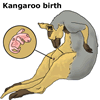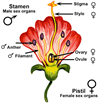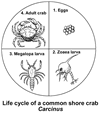What came first, the chicken or the egg? The life cycle goes on....
Some further examples of interesting different life cycles, often discussed in primary classrooms, are outlined below (see also Life cycles A: General stages - Butterflies and frogs):
Chickens
 The
adult male (rooster or cock) mates with the hen by climbing on her back
and placing his
opening (cloaca) against hers, and his sperm swims up the oviduct
to fertilise the eggs. The "white" and soft shell are then deposited
around the fertilised egg as it passes down the oviduct, and the shell
then hardens before the egg is laid. The embryo develops in the egg using
food from the yolk, and oxygen from the air sac.
The
adult male (rooster or cock) mates with the hen by climbing on her back
and placing his
opening (cloaca) against hers, and his sperm swims up the oviduct
to fertilise the eggs. The "white" and soft shell are then deposited
around the fertilised egg as it passes down the oviduct, and the shell
then hardens before the egg is laid. The embryo develops in the egg using
food from the yolk, and oxygen from the air sac.

The egg must be regularly turned and kept warm in an incubator or by a
brooding hen on the nest. After 21 days, the chick pecks its way out.
The yellow fluff (down) is later replaced by feathers and continued growth
produces an adult bird.
Kangaroos
 Adult male roos fight to determine "dominance",
with the strongest males winning the right to mate. Mating occurs by the
male inserting his penis in the female's vagina and depositing sperm which
fertilise the egg cells. The embryo develops in the womb until it is about
3 cm long. Then it emerges through the birth canal and crawls across the
fur into the pouch following a scent trail licked by the mother. Here
it grows, attached to a teat, until about four months old when it starts
to come out occasionally and eat grass, returning to the pouch for protection
and further nourishment. After growing to maturity, adult kangaroos will
reproduce only if environmental conditions are favourable.
Adult male roos fight to determine "dominance",
with the strongest males winning the right to mate. Mating occurs by the
male inserting his penis in the female's vagina and depositing sperm which
fertilise the egg cells. The embryo develops in the womb until it is about
3 cm long. Then it emerges through the birth canal and crawls across the
fur into the pouch following a scent trail licked by the mother. Here
it grows, attached to a teat, until about four months old when it starts
to come out occasionally and eat grass, returning to the pouch for protection
and further nourishment. After growing to maturity, adult kangaroos will
reproduce only if environmental conditions are favourable.
Flowering plants
 The life cycle of flowering plants involves seed germination, seedling
growth, formation of flower, gamete production (pollen and ovules), pollination,
fertilisation, development of the seeds inside a seed pod or fruit and
dispersal of the seeds.
The life cycle of flowering plants involves seed germination, seedling
growth, formation of flower, gamete production (pollen and ovules), pollination,
fertilisation, development of the seeds inside a seed pod or fruit and
dispersal of the seeds.
(For full description see Plant
systems C: Reproduction and flowering plants)
Tapeworms
Tapeworms are an example of a hermaphroditic organism which must self-fertilise
for the species to survive.
 Tapeworms are parasites in the intestines of warm-blooded animals
such as dogs and humans. They are usually hermaphroditic, producing both
eggs and sperm. The self-fertilised eggs pass out with the faeces for
dispersal.
Tapeworms are parasites in the intestines of warm-blooded animals
such as dogs and humans. They are usually hermaphroditic, producing both
eggs and sperm. The self-fertilised eggs pass out with the faeces for
dispersal.
Pet dogs can easily become infected. Children should wash their hands after playing with dogs as the tiny eggs are easily picked up and passed to the mouth when eating, starting the growth cycle again.
Shore
crabs This is an example of an organism which shows several larval forms in
its life cycle.
This is an example of an organism which shows several larval forms in
its life cycle.
| Copyright owned by the State of Victoria (Department of Education and Early Childhood Development). Used with Permission. |